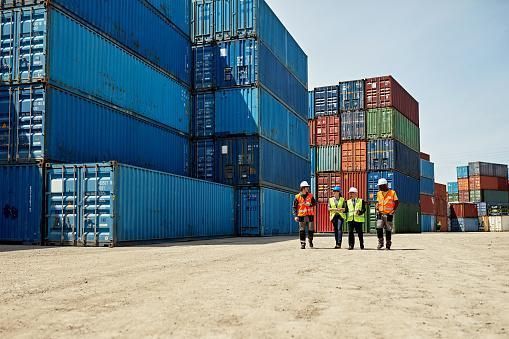How Does Freight Management Work
How Does Freight Management Work?
Freight management is the process of overseeing the transportation of goods from the point of origin to the point of destination. It involves a variety of different tasks, including selecting carriers, coordinating shipments, managing inventory, and ensuring that goods are delivered on time and in good condition.
In this blog post, we'll take a closer look at how freight management works and what you can expect if you're involved in the transportation of goods.
Working Of Freight Management-Step By Step Process
Working freight management involves several steps that need to be taken to ensure the efficient and successful delivery of goods.
Step 1: Planning And Coordination
The first step in freight management is planning and coordination. This involves determining the best route for transporting the goods, selecting the appropriate mode of transportation, and scheduling the shipment. Depending on the nature of the goods being transported, the shipment may be coordinated by a variety of different parties, including manufacturers, distributors, and retailers.
During the planning and coordination phase, it's important to take into account factors such as:
- Transit time: How long will it take for the goods to reach their destination? Will they be transported by air, sea, or land?
- Cost: What is the cost of the shipment, including transportation fees, insurance, and any customs duties or taxes?
- Capacity: Do you have enough space in your warehouses or trucks to store and transport the goods?
- Regulatory compliance: Are you complying with all relevant laws and regulations, such as those related to customs, safety, and security?
Step 2: Carrier Selection
Once the shipment has been planned and coordinated, the next step is to select a carrier. This can be a complex process, as there are many different carriers to choose from, each with its strengths and weaknesses. Some of the factors that may be considered when selecting a carrier include:
- Mode of transportation: Does the carrier specialize in air, sea, or land transportation?
- Cost: What is the carrier's pricing structure? Does it offer volume discounts or other incentives?
- Capacity: Does the carrier have the necessary equipment and space to transport the goods?
- Reliability: Has the carrier been reliable in the past? What is its track record for on-time deliveries?
- Safety and security: Does the carrier have a good safety record? Does it have appropriate security measures in place to protect the goods during transit?
Read More: Who Is A Freight Broker And What Do They Do?
Step 3: Shipment Coordination
Once a carrier has been selected, the next step is to coordinate the shipment. This involves working with the carrier to ensure that the shipment is properly loaded, transported, and delivered. Depending on the nature of the goods being transported, this may involve a variety of different tasks, such as:
- Packaging and labelling: Are the goods properly packaged and labelled for transportation?
- Loading and unloading: Are the goods being loaded and unloaded safely and efficiently?
- Documentation: Are all necessary documents, such as bills of lading and customs declarations, in order?
- Tracking and monitoring: Are the goods being tracked and monitored throughout the entire transportation process?
- Delivery: Is the carrier delivering the goods on time and in good condition?
Read More: How Long Does Customs Clearance Take?
Step 4: Inventory Management
Another important aspect of freight management is inventory management. This involves ensuring that the right amount of goods are in the right place at the right time. Depending on the nature of the goods being transported, this may involve a variety of different tasks, such as:
- Warehousing: Are the goods being stored in a secure and appropriate location?
- Stocking: Is the inventory being restocked promptly to ensure that there are always enough goods on hand?
- Order fulfilment: Are customer orders being fulfilled quickly and efficiently?
- Demand forecasting: Are you forecasting demand accurately to ensure that you have the right amount of inventory on hand?
- Returns management: Are returns being processed quickly and efficiently?
Freight management is a complex process that requires careful coordination and planning to ensure that goods are transported safely, securely, and on time. By understanding the steps involved in freight management, you can ensure that your shipments arrive safely and on time, every time.
Read More: Road Freight Transport Explained
Step 5: Cost Management
Cost management is an important component of freight management. This involves understanding the different costs associated with a shipment, such as fuel costs, maintenance costs, and labour costs. It also involves looking for ways to reduce those costs while still delivering goods on time and in good condition.
One way to do this is by taking advantage of discounts and special offers from carriers or freight brokers. Another way is to optimise routes and schedules to reduce fuel costs and other associated expenses.
Step 6: Monitoring And Reporting
Monitoring and reporting are essential components of freight management. This involves tracking the progress of shipments in real-time to ensure that deliveries arrive on time and in good condition.
It also involves generating reports about delivery performance, cost management, and inventory levels to help you better understand and manage the process. These reports can be used to identify areas for improvement.
Step 7: Risk Management
Risk management is another important component of freight management. This involves assessing risks associated with each shipment, such as potential delays or damaged goods due to inclement weather or other unforeseen circumstances.
It also involves looking for ways to reduce those risks by taking measures such as purchasing cargo insurance, working with reliable carriers and brokers, and implementing safety protocols. By understanding and managing the risks associated with freight shipments, you can ensure that goods are delivered safely and securely.
Step 8: Customer Service
Customer service is an essential component of freight management. This involves ensuring that customers are kept up to date with the progress of their shipments and providing them with any support or assistance they may require.
It also involves dealing with any customer complaints or disputes in a timely and professional manner. By providing excellent customer service, you can ensure that customers remain satisfied and loyal to your business.
Final Words:
Freight management is an essential part of any business that involves the transportation of goods. By understanding the steps involved in freight management, you can ensure that shipments arrive safely and on time and that customers are kept satisfied with their service. With careful planning and cost optimisation, you can make sure that your business runs smoothly and efficiently.










